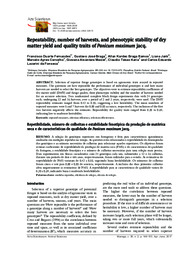Repeatability, number of harvests, and phenotypic stability of dry matter yield and quality traits of Panicum maximum jacq.
Repeatability, number of harvests, and phenotypic stability of dry matter yield and quality traits of Panicum maximum jacq.
Author(s): FERNANDES, F. D.; BRAGA, G. J.; RAMOS, A. K. B.; JANK, L.; CARVALHO, M. A.; MACIEL, G. A.; KARIA, C. T.; FONSECA, C. E. L. da
Summary: Selection of superior forage genotypes is based on agronomic traits assayed in repeated measures. The questions are how repeatable the performance of individual genotypes is and how many harvests are needed to select the best genotypes. The objectives were to estimate repeatability coefficients of dry matter yield (DMY) and forage quality, their phenotypic stability and the number of harvests needed for an accurate selection. Two randomized complete block design experiments data with 24 genotypes each, undergoing 12 and 16 harvests, over a period of 2 and 3 years, respectively, were used. The DMY repeatability estimates ranged from 0.42 to 0.55, suggesting a low heritability. The mean numbers of repeated measures were 5 and 7 harvests for 0.80 and 0.85 accuracy, respectively. The inclusion of the first two harvests negatively affects the estimates. Repeatability for quality traits ranged from 0.30 to 0.69, indicating low to moderate heritability.
Publication year: 2017
Types of publication: Journal article
Unit: Embrapa Beef Cattle
Keywords: Colheita, Cultivars, Eficiência de seleção, Eficácia de seleção, Forrageira, Genótipo, Grazing, Matéria seca, Medida repetida, Medidas repetidas, Megathyrsus maximus, Melhoramento genético, Panicum maximum, Pastagem, Pastejo, Repeated measures, Selection effectiveness, Selection efficiency, Seleção de genótipos
Observation
Some of Embrapa's publications are published as ePub files. To read them, use or download one of the following free software options to your computer or mobile device. Android: Google Play Books; IOS: iBooks; Windows and Linux: Calibre.
Access other publications
Access the Agricultural Research Database (BDPA) to consult Embrapa's full library collection and records.
Visit Embrapa Bookstore to purchase books and other publications sold by Embrapa.

